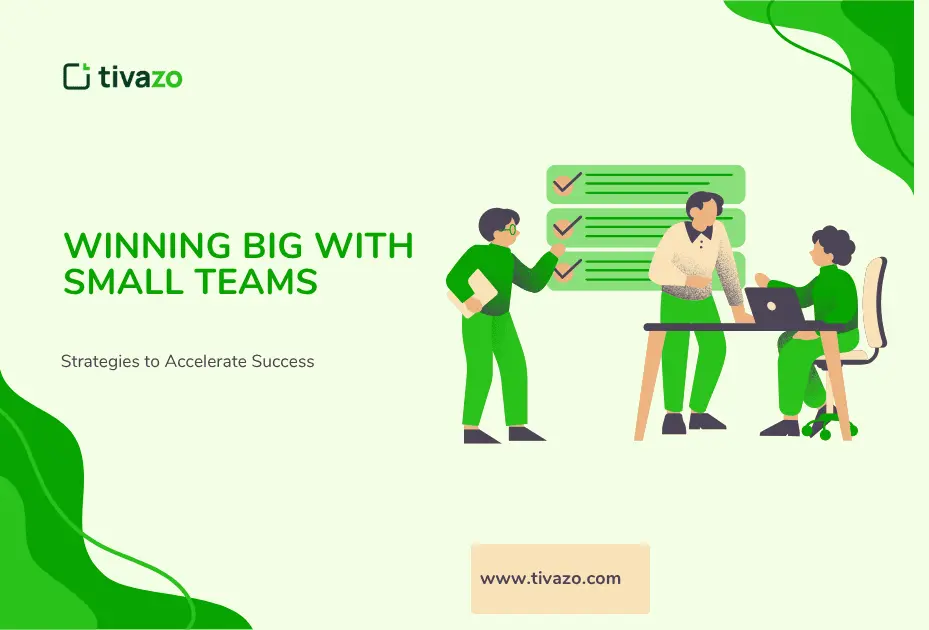In today’s competitive business environment, employee recognition is not simply a good thing to have; it is now a necessity. Recognition is a strong force that positively affects employee morale, contributes to employee productivity, and is a critical component of employee retention. Recognition and appreciation, when done well, is key to creating a culture where employees feel valued and appreciated, resulting in higher employee engagement and strong dedication to the company’s goals.
In this blog, we will examine in detail the importance of employee recognition, the variety of forms employee recognition may take, as well as how to develop a culture of recognition that will be life-changing for your workplace.
Key Highlights:
- What do you mean by Employee Recognition
- Why is Employee Recognition Important
- Link Between Employee Recognition and Employee Engagement
- Employee Recognition Best Practices
- Challenges in Employee Recognition
- Building Employee Recognition into Daily Operations
- How Tivazo helps in employee recognition
What do you mean by employee recognition?
Employee recognition is the practice of recognizing and appreciating the contributions of your employees’ hard work and efforts. Recognition can take on many forms. Recognition can be formalized and structured, such as awards or bonuses, but can also take on less formal structures, such as verbally saying thank you to an employee or giving them a public shout-out.
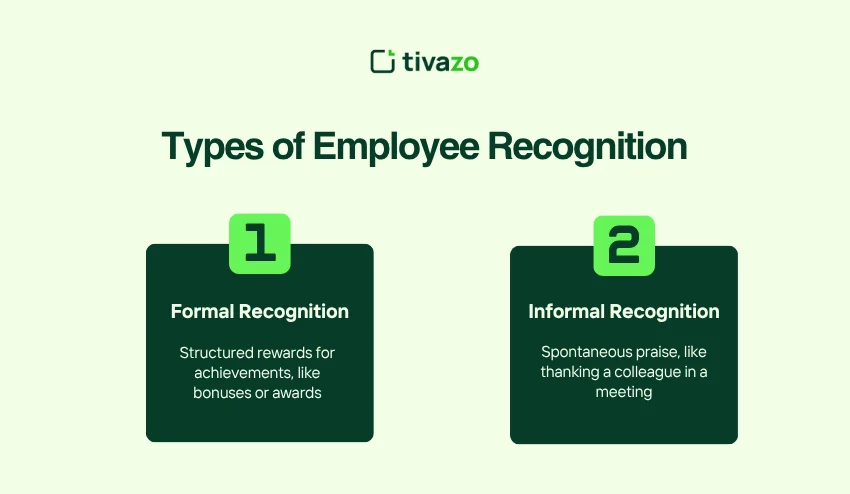
- Formal Recognition: This includes forms of recognition such as employee of the month programs, performance bonuses, or celebrations for special milestones. For instance, a company such as SheetzFEST provides a fully hosted stay at a resort, reflecting how much they value their employees.
- Informal Recognition: Showing recognition during a one-on-one meeting when the employee is being reviewed or providing public recognition of an employee on internal communication platforms has a long-term positive impact. Similar to formal recognition, Sedgwick has a program called Props to let employees recognize each other for the contributions they have made.
A comprehensive recognition program has a significant impact on employees feeling valued, which increases their engagement to the organization.
Why is Employee Recognition Important?
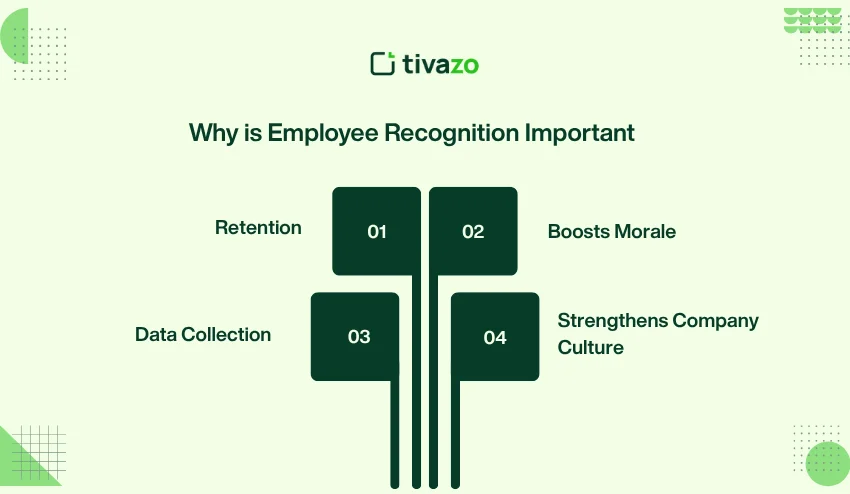
1. Retention:
Employees stay at an organization where they feel appreciated regularly. According to research conducted by the Great Place To Work Institute, employees are 7x more likely to stay with a company that offers meaningful recognition. A culture of recognizing employees builds loyalty and keeps your top talent engaged.
2. Boosts Morale:
Recognizing employees creates a positive work environment and elevates morale. A simple “thank you” or recognizing an employee publicly at a team meeting can create a positive work environment. When employees feel recognized and valued in the workplace, they tend to contribute more and go above and beyond with their responsibilities.
3. Enhances Productivity:
Recognition is connected to productivity. Employees do not produce their best work if they feel unrecognized, and unproductive work can cost companies as much as $15,000 per hour each year, according to McKinsey. Employees will expend 2.2x more effort working for a company with a strong recognition culture.
4. Strengthens Company Culture:
When recognition becomes part of the culture in your company, you create alignment that engages employees around company values and goals. This engagement creates pride and belonging, which produces levels of satisfaction in their work.
The Link Between Employee Recognition and Employee Engagement
Employee engagement is crucial to the success of an organization. Engaged employees are productive, innovative, and committed to the company’s goals. A study by Great Place To Work points out that the 100 Best Companies in the U.S. produce a revenue per employee that is 5x greater than their competitors.
What is one of the main drivers? Employee recognition. Engaged employees feel seen and appreciated and are more likely to show up to work as their best selves, leading to a higher level of individual worker performance.
7 Employee Recognition Strategies to Inspire Excellence
Recognition programs that work can drive motivation, performance and enhance your culture. Here are 7 recognition strategies you can implement to make your employee recognition feel more engaging and sustainable.

1. Peer-to-Peer Recognition Programs
Offer employees the opportunity to recognize and reward each other’s contributions. For example, Kudos at Atlassian creates an uplifting and supportive space that builds an atmosphere where employees have the opportunity for recognition. Peer recognition builds relationships with co-workers and emphasizes inclusiveness, connection, and cooperation in their essential role in the workplace.
- Promotes collaboration among employees;
- Fosters a positive company culture that recognizes the value of contributions regardless of position;
Builds respect and understanding among peers.
2. Public Shout-Outs and Praise
Recognizing accomplishments and successes publicly (i.e., in meetings or via company-wide newsletters) can be a true method of developing employee pride, building awareness, and also serving as an encouragement for others. Positively referencing employees’ hard work publicly in front of other team members empowers employees and encourages employees to take further action and continue striving for excellence.
- Creates visibility and pride for employees.
- Builds team morale and cohesion.
- Encourages healthy competition and continued success moving forward.
3. Personalized Thank-You Notes
Handwriting a short note can be very effective. A personal and specific recognition makes it feel more sincere and significant to the employee. Taking the time to write a personalized note shows you genuinely appreciate the individual and may deepen the employee-manager relationship.
- Adds a personal touch, therefore the recognition feels more authentic.
- Can provide specific feedback examples that support those positive behaviors.
- Helps build stronger relationships and trust between managers and employees.
4. Employee-of-the-Month Awards
Regularly recognize top performers via employee of the month-type programs. It is important that the criteria for recognition are transparent and tie to your values so that your employees feel the option is fair and motivational. This concept can produce some healthy competition and employees will see clear goal they should be working for while feeling appreciated for their efforts.
- Clear criteria understand exactly how to be successful.
- Recognizes an employee for consistent performance and public recognizes them.
- Creates a sense of accomplishment within the employee and spurs on other employees.
5. Spot Bonuses and Performance Rewards
Spot bonuses or compensation-based performance rewards are a great way to provide immediate recognition for employees who consistently exceed expectations or within the confines of key performance indicators. These rewards recognize effort in the moment, establish a tangible association of recognition and compensation with individual performance, and motivate the employee to continue performing at high levels.
- Provides immediate feedback and acknowledgement of extraordinary performance.
- Benefits are associated with team or individual performance.
- Creates motivation and incentivizes further distinguished performance.
6. Team-Based Recognition
Recognize accomplishments as a team, not as individuals. Recognize how individual performance translates into the overall accomplishment of the larger goals of the organization. This promotes a sense of companionship, belonging and helps employees to work together towards mutual goals.
- Promotes teamwork and supports collaboration.
- Reinforces the idea that success is through the collective value of some type of goal.
- Helps create a sense of community connected to the team.
7. Recognition Through Career Development
You can provide opportunities for promotions, training, or mentorship as a form of recognition for good employees who garner consistent results. This creates value beyond any financial recognition and shows you are committed to their future career like most employees will want to be in their careers. Employees will then feel a sense of loyalty when you are personally developing them as employees.
- Provides value and growth opportunities for long-term value.
- Shows commitment to employee development.
- Helps increase employee retention and satisfaction.
Creative Employee Recognition Ideas
Employee recognition doesn’t always have to be a one-off occasion for any employee; it can be an ongoing process to recognize the breadth of an employee’s contribution. Creative recognition motivates employees and builds a positive company culture where employees feel recognized for their contributions. Here are some unique and significant recognition opportunities to build recognition from a culture of appreciation:
1. Peer-to-Peer Recognition Programs:
Programs like Kudos at Atlassian allow employees to recognize each other. This opportunity builds the connections and bonds among teams, and all employees get the chance to be recognized, not just the high-performing employees.
2. Personalized Thank-You Notes:
Even a simple handwritten note of thanks can make a major difference. Make it specific to the actions taken that made an impact.
3. Public Praise and Acknowledgment:
When you publicly acknowledge employees in team meetings, company-wide newsletters, or town halls, it lets the recognized employee know that they are part of the team.
4. Employee-of-the-Month Programs:
Create a way to identify and consistently recognize employees. Make sure its transparent and fair, and that it aligns with the values of the organization.
How to Build a Culture of Recognition
Developing a culture of recognition does not happen overnight and requires a purposeful strategy where every employee feels valued for the contributions they provide. Here are key practices to help you build a culture of recognition:
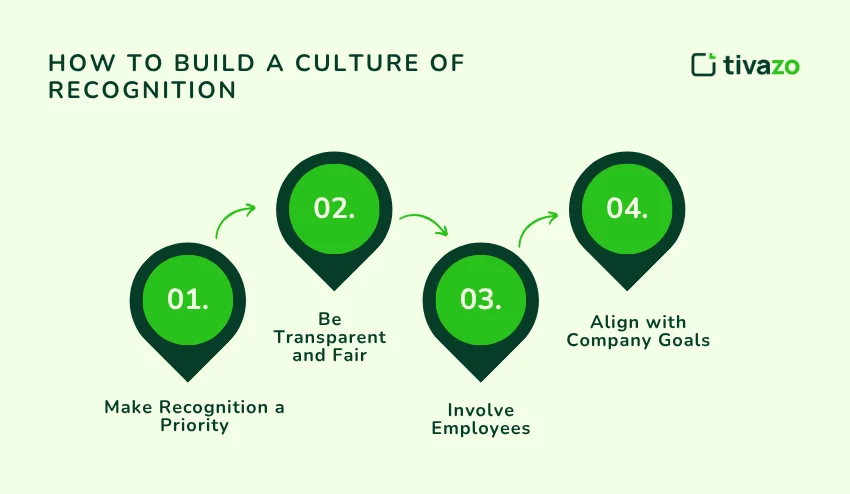
- Make Recognition Intentional:
- Recognition is a practice that should be intentionally incorporated into your workplace culture as a consistent habit. Whether it’s a shout-out in weekly meetings or recognizing peers in a meeting, incorporate it into your daily workplace routines.
- Be Transparent and Fair:
- Make sure that the recognition is based on clear and measurable criteria. Do not show favoritism, and make sure that everyone is eligible for recognition.
- Involve Employees:
- Allow employees to participate in the recognition program by obtaining employee feedback on the program, and involve them in determining how recognition occurs.
- Align with Company Goals:
- Ensure that recognition ties back to company values and company goals so employees see that their contributions contribute to the overall success of the company.
Employee Recognition Best Practices
Employee recognition is most meaningful when it is thought out and intentional. If you utilize these best practices, the recognition you provide can be impactful and meaningful:
- Be Specific: Instead of simply saying “good job,” commend them on what you appreciated.
- Be Timely: Recognize accomplishments when they happen, rather than months after the accomplishment.
- Be Personal: Understand how each employee would like to be recognized (e.g., some employees may prefer public praise while others would prefer private praise).
Challenges in Employee Recognition and How to Overcome Them
Even though employee recognition can produce great value, obstacles related to employee recognition have to be successfully managed by organizations:
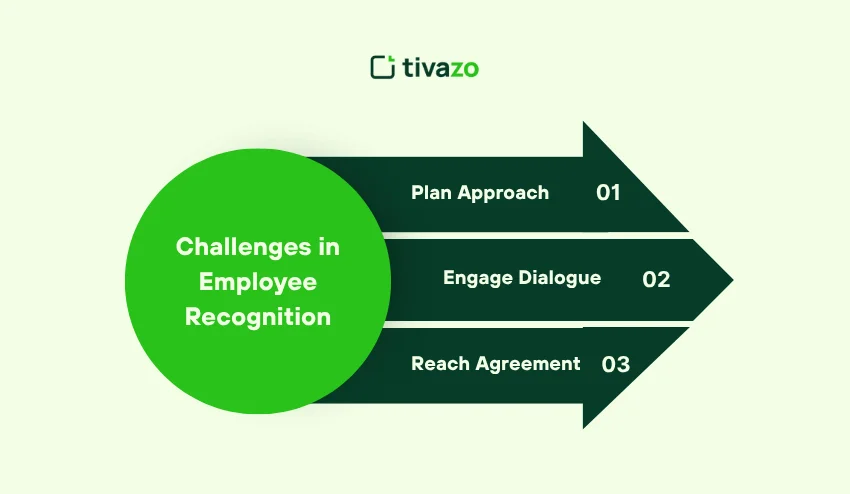
- Lack of Consistency: Turn recognition into a normal routine so that it is consistently delivered as part of your operations.
- Perceptions of Favoritism: You want employees to feel like recognition is equitably and transparently delivered. Be sure to rotate the employee being recognized, and have and clearly communicate the criteria for recognition so that employees trust the system.
- Remote Work: Use technology to recognize efforts on global teams.
Building Employee Recognition into Daily Operations
Recognition should be easy to seamlessly, part of everyday, and embedded into your operations. Make it easy for managers or co-workers to recognize outstanding accomplishments and contributions. Here are some things to consider:

- Daily Acknowledgments: Recognize small wins every day that deserve recognition, not only at major meetings or special recognition days throughout the year.
- Use technology: Use technology to easily generate shout-outs. Use Slack, Teams, or an online employee recognition platform to effortlessly give an easy spontaneous shout-out.
- Recognition of team success: Recognize the success of a team to foster collaboration and team morale, for example after a successful campaign or product launch.
Embedding Recognition into the routine produces a workplace where employees feel valued day-to-day experience.
How Tivazo helps in employee recognition
Tivazo supports employee recognition by supplying an understanding of key employee attributes, such as punctuality, efficiency, and diligence, through time tracking and activity monitoring. Tivazo allows managers to provide detailed, objective performance feedback with performance reports that highlight positive behavior as well as opportunities for improvement. With the data provided, managers can reward employees fairly, making it easier to drive the motivation and engagement of employees in their performance review and career development. Simply put, Tivazo provides the opportunity for objective recognition in the workplace, based on fact, that helps create an engaged and productive workforce.
Conclusion
Employee recognition is one of the most effective tools that a company can wield to facilitate employee engagement, productivity, and retention. When you create an environment where employees feel valued and appreciated, you should witness marked improvements in employee morale, job satisfaction, and overall performance.
So what are you waiting for? Create a culture of recognition today and unlock the fullest potential of your team.
Try Tivazo now and see how it can change the way you engage your employees.

